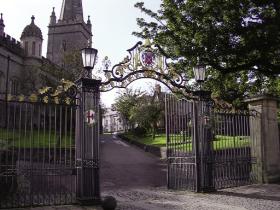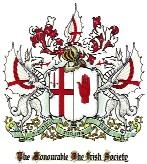The Honourable The Irish Society: still in business
Published in 18th–19th - Century History, 20th-century / Contemporary History, Early Modern History (1500–1700), General, Issue 6 (Nov/Dec 2009), News, Plantation of Ireland, Volume 17
The Processional Gates of St Columb’s Cathedral—through its continuing ownership of the city walls and its contribution towards the building of St Columb’s, the Guildhall and numerous lesser public buildings, the Irish Society has remained closely involved in the development of Londonderry. (The Honourable the Irish Society)
In 1608–9, through a mixture of threats and promises from James I, the City of London become involved in the most planned and orderly of the various plantation schemes in Ireland. Fifty-five of its livery companies eventually became financial backers of the plantation, and in return their governing body, the Irish Society, received a royal charter in March 1613. The charter conferred enormous amounts of land and property rights on the Irish Society, which promptly subdivided the great majority of this among its supporting livery companies, who had raised an initial sum of £60,000 to fund the plantation of County Londonderry.
In the following centuries Irish Society agents frequently deplored, in their detailed reports to London, the lack of interest and investment displayed by some of the livery companies in their estates, although others were praised for their philanthropy and concern. It is ironic that in the mid-nineteenth century, as the companies became heavily involved in philanthropic works in County Londonderry, erecting schools, bridges, houses and public buildings, they fell victim to Gladstone’s land reform policies in Ireland. Their demise and withdrawal by the early twentieth century left the Irish Society, which largely owned urban property and fisheries that were exempt from the land acts, alone as the City of London’s link to the county. Today, the livery companies continue to play an important charitable role in Britain, especially in the field of education. Even after the experiences of the past, some of the companies still regularly assist projects in their former estates in County Londonderry, and often this is done in collaboration with the Irish Society.
The Irish Society was directed in its royal charter to pay especial attention to the development of the ‘new’ towns of Londonderry and Coleraine. After a remarkably short time, both towns were rebuilt and fortified to become the mainstays of the plantation in north-west Ulster. Through its continuing ownership of the city walls in Londonderry and its contribution towards the building of St Columb’s Cathedral, the Guildhall and numerous lesser public buildings, the Irish Society has remained closely involved in the development of Londonderry ever since. Even today it plays an active role, working with the city council, statutory bodies and government departments, seeking to bring expertise from the City of London to local advantage. The same is true for Coleraine, and it may be worth noting that the Irish Society not only offers a ‘London link’ to both places but also serves to bind them together. Given the deep political and cultural differences existing between Londonderry and Coleraine, this is perhaps no small achievement.
 The Irish Society continues to manage its (much reduced) property portfolio in Londonderry and Coleraine, which, together with the fisheries of the Lower Bann, contribute significantly to the charitable works it undertakes in the county, especially in the field of education. Whilst it will never be anything other than a relatively small grant-giving charitable body, it has the additional role of maintaining and developing the relationship between London and County Londonderry. That aspect offers considerable potential for greater development, not least as the trend towards globalisation of markets and business makes it all the more important for small cities and towns to make use of their assets and any ‘special relationships’ that may exist. This is clearly recognised by civic and business leaders in both Londonderry and Coleraine.
The Irish Society continues to manage its (much reduced) property portfolio in Londonderry and Coleraine, which, together with the fisheries of the Lower Bann, contribute significantly to the charitable works it undertakes in the county, especially in the field of education. Whilst it will never be anything other than a relatively small grant-giving charitable body, it has the additional role of maintaining and developing the relationship between London and County Londonderry. That aspect offers considerable potential for greater development, not least as the trend towards globalisation of markets and business makes it all the more important for small cities and towns to make use of their assets and any ‘special relationships’ that may exist. This is clearly recognised by civic and business leaders in both Londonderry and Coleraine.
The Irish Society has successfully managed to adapt and change over the centuries, defying the predictions of many who expected it to wither away once the plantation took root. Today, those who govern it are still acutely aware and supportive of its heritage and traditions, whilst being able to apply the values and judgements of modern times. All in all, it is hard to deny that at least in one aspect the outcome of the County Londonderry plantation has been beneficial. HI
Edward Montgomery has been Representative in Ireland for the Honourable the Irish Society since 1996 and is also managing director of Bann System Ltd, its fishery subsidiary.
















